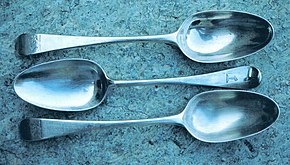Oligodynamic effect

The oligodynamic effect (from
In modern times, the effect was observed by
Mechanism
The metals react with
List of uses
Aluminium
Aluminum has been found to compete with iron and magnesium and bind to DNA, membranes, or cell walls, leading to its toxic effect on microbes, such as cyanobacteria, soil bacteria and mycorrhizal fungi.[4]
Aluminium triacetate (Burow's solution) is used as an astringent mild antiseptic.[5]
Antimony
Arsenic
For many decades,
Barium
Barium polysulfide is a fungicide and acaricide used in fruit and grape growing.[9]
Bismuth
Bismuth compounds have been used because of their
Boron
Copper
Brass vessels release a small amount of copper ions into stored water, thus killing fecal bacterial counts as high as 1 million bacteria per milliliter.[13]
Paint containing copper is used on boat bottoms to prevent barnacle growth (biofouling).
Copper also has the ability to destroy viruses, such as influenza viruses, noroviruses or human immunodeficiency virus (HIV).[16]
Gold
Gold is used in dental inlays and inhibits the growth of bacteria.[17]
Lead
Physicians prescribed various forms of lead to heal ailments ranging from
Mercury
Organic mercury compounds have been used as topical disinfectants (
Nickel
The toxicity of nickel to bacteria, yeasts, and fungi differs considerably.[22]
Silver
The metabolism of bacteria is adversely affected by silver ions at concentrations of 0.01–0.1 mg/L. Therefore, even less soluble silver compounds, such as silver chloride, also act as bactericides or germicides, but not the much less soluble silver sulfide. In the presence of atmospheric oxygen, metallic silver also has a bactericidal effect due to the formation of silver oxide, which is soluble enough to cause it. Even objects with a solid silver surface (e.g., table silver, silver coins, or silver foil) have a bactericidal effect. Silver drinking vessels were carried by military commanders on expeditions for protection against disease. It was once common to place silver foil or even silver coins on wounds for the same reason.[23]
Silver sulfadiazine is used as an antiseptic ointment for extensive burns. An equilibrium dispersion of colloidal silver with dissolved silver ions can be used to purify drinking water at sea.[3] Silver is incorporated into medical implants and devices such as catheters. Surfacine (silver iodide) is a relatively new antimicrobial for application to surfaces. Silver-impregnated wound dressings have proven especially useful against antibiotic-resistant bacteria. Silver nitrate is used as a hemostatic, antiseptic and astringent. At one time, many states[clarification needed] required that the eyes of newborns be treated with a few drops of silver nitrate to guard against an infection of the eyes called gonorrheal neonatal ophthalmia, which the infants might have contracted as they passed through the birth canal. Silver ions are increasingly incorporated into many hard surfaces, such as plastics and steel, as a way to control microbial growth on items such as toilet seats, stethoscopes, and even refrigerator doors. Among the newer products being sold are plastic food containers infused with silver nanoparticles, which are intended to keep food fresher, and silver-infused athletic shirts and socks, which claim to minimize odors.[15][17]
Thallium
Thallium compounds such as
Tin
Zinc
Zinc oxide is used as a weak antiseptic and in paints as a white pigment and mold-growth inhibitor.[27] Zinc chloride is a common ingredient in mouthwashes and deodorants, and zinc pyrithione is an ingredient in antidandruff shampoos. Galvanized (zinc-coated) fittings on roofs impede the growth of algae. Copper- and zinc-treated shingles are available.[15] Zinc iodide and zinc sulfate are used as topical antiseptics.[28]
Safety
Besides the individual toxic effects of each metal, a wide range of metals are
See also
References
- PMID 34665632.
- ^ Nägeli, Karl Wilhelm (1893), "Über oligodynamische Erscheinungen in lebenden Zellen", Neue Denkschriften der Allgemeinen Schweizerischen Gesellschaft für die Gesamte Naturwissenschaft, XXXIII (1)
- ^ ISBN 978-3527306732
- ISSN 0966-0844.
- ISBN 978-1-4051-6169-5
- ISBN 978-3527306732
- ISBN 978-1-4200-4479-9
- ISBN 978-0-12-745354-5
- ISBN 978-3527306732
- ISBN 978-3527306732
- ISBN 978-0-12-745354-5
- ISBN 978-3527306732
- ^ ISBN 978-0-321-71271-4
- ISBN 978-0-12-745354-5
- ^ ISBN 978-0-321-55007-1
- PMID 29280540.
- ^ ISBN 978-0-07-352252-4
- ISBN 978-3527306732
- ISBN 978-0-12-745354-5
- ISBN 978-3527306732
- ISBN 978-0-12-745354-5
- ISBN 978-3527306732
- ISBN 978-3527306732
- ISBN 978-3527306732
- ISBN 978-0-12-745354-5
- ISBN 978-3527306732
- ISBN 978-1-4200-4479-9
- ISBN 978-3527306732
- ISBN 978-0-12-745354-5
- ISBN 978-1-925129-36-6
- ISBN 978-0-12-745354-5
Links
- Lilaria, Khushboo; Gupta, Nisha; Paul, Jai Shankar; Jadhav, Shailesh Kumar (31 December 2020). "Comparative Analysis of Oligodynamic Virtue of Various Metals on Bacterial Population". NewBioWorld. 2 (2): 8–12. .
